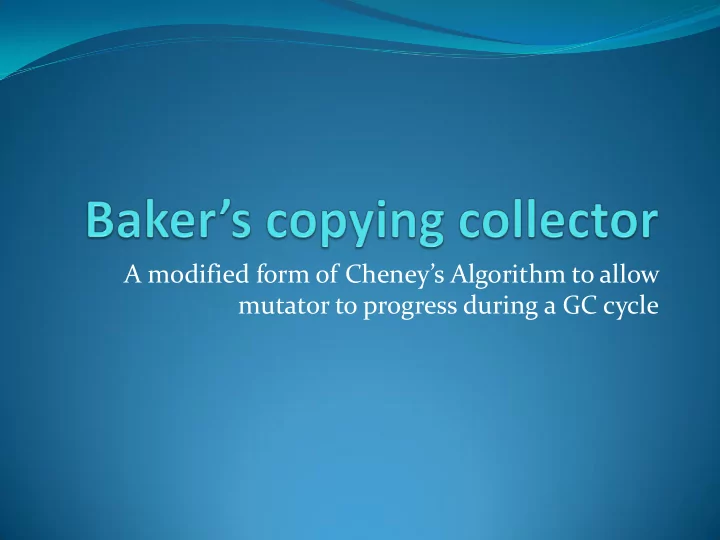

A modified form of Cheney’s Algorithm to allow mutator to progress during a GC cycle
Main idea of Baker’s algorithm Don’t let the mutator see a white object Cannot disrupt collect During collection each mutator read from from_space is trapped by read-barrier It is copied to to_space It is colored grey (or black) Address of copy returned to mutator Writes are not affected 2
Best known read-barrier collector to_space Tospace new allocations copied objects bottom top scan B T Allocation occurs at top of to_space 3
Issues to resolve Should mutator be allowed to read grey objects as well as black objects? How much work should read-barrier be allowed to do? least amount of work: Evacuate from_space object into to-space Tricolor abstraction: Color white objects grey Return address of grey object to mutator 4
Issues to resolve Should mutator be allowed to read grey objects as well as black objects? How much work should read-barrier be allowed to do? Black only read-barrier: Copy and scan object Potentially blacken other grey objects Return address of black object to mutator 5
Advantages and disadvantages Advantages: Collect does not need to scan new objects Could not have been initialized with refs to from_space Disadvantages: No new objects can be reclaimed until next cycle Read-barrier is more conservative than incremental- update write-barrier approaches 6
Baker’s incremental copying alg new(n){ if (B ≥ T – n){ // flip phase if (scan < B) abort “ Have not finished scavenging ” flip() for (R in roots) { R = copy(R)} // Not RT } repeat k times while (scan < B) { for (P in children(scan)) {*P = copy(P)} scan = scan + size(scan) } if (B == T) abort “ heap full ” T = T – n return T } 7
Baker’s incremental copying alg read(T){ T ´ = copy(T)} return T ´ } Evacuates a single object at a time 8
Copying for variable-sized objects // P points to memory location, not an address copy(P) { if (atomic(P) or P == nil) return P // P is not a pointer if not forwarded(P) // P stores a forwarding address after copied n = size(P) P ´ = free // reserve space in to_space for copy of P free = free + n temp = P[0] // P[0] holds forwarding address forwarding_address(P) = P ´ P ´ [0] = copy(temp) // Restore P[0] // Copy each field of P in to P ´ for i = 1 to i = n – 1 P ´ [i] = copy(P[i]) return forwarding_address(P) // Stored in P[0] } 9
Flipping Routine from Cheney’s alg flip() { to_space, from_space = from_space, to_space top_of_space = to_space + space_size free = to_space for R in Roots R = copy(R) // Root pointer now points to copy of R } In Baker’s algorithm, copying of root objects not done as part of flip routine 10
Flipping semi-spaces Flipping when pointers meet (B & T) Minimizes amount of copying by allowing objects enough time to die Maximizes amount of heap allocated Maximizes number of page faults Flipping as soon as collection cycle is completed Compacts data using fewer pages Reduces chance of page faults Flipping also checks that to_space is large enough K objects scanned at each allocation 11
Limitations on Baker’s algorithm Latency: Root set must be scavenged atomically at flip time Difficult to provide small upper bound on new() if root set is large Cost of evacuating an object depends on its size Solution: use backward link to lazily copy and scan large objects Time to access an object depends on whether it is in to_space or from_space Performance of read-barrier is less predictable than write-barrier 12
Variations on Baker’s algorithm Most sought to either Reduce cost of barrier, or Make length of pause more predictable 13
Brooks variation Reduce cost of read-barrier Eliminate conditional check and branch that determines whether an object should be forwarded Instead, all objects are referred to via indirection field in header If object has been coped indirection field refers to to_space copy If object has not been copied indirection field refers to from_space copy To prevent installation of black-white pointers update method is required to forward 2 nd argument 14
Brook’s forwarding pointers Jones and Lin: Diagram 8.10 15
Brooks approach Is actually an incremental-update write-barrier instead of a read-barrier Adds space overhead for forwarding pointer Time overhead due to indirection Balanced by lower frequency of write-barrier 16
Recommend
More recommend